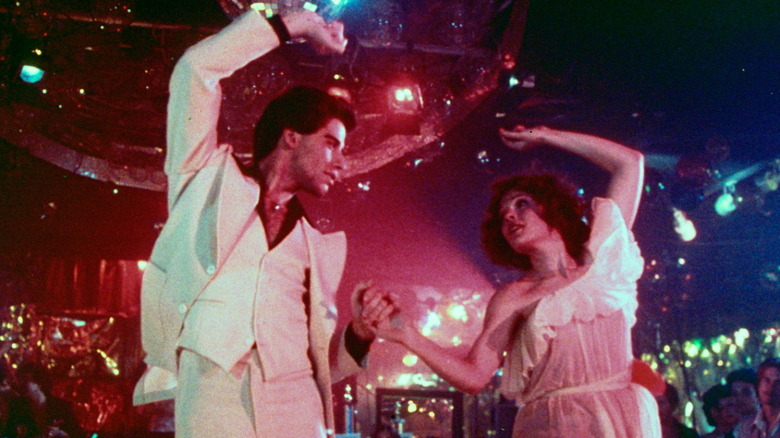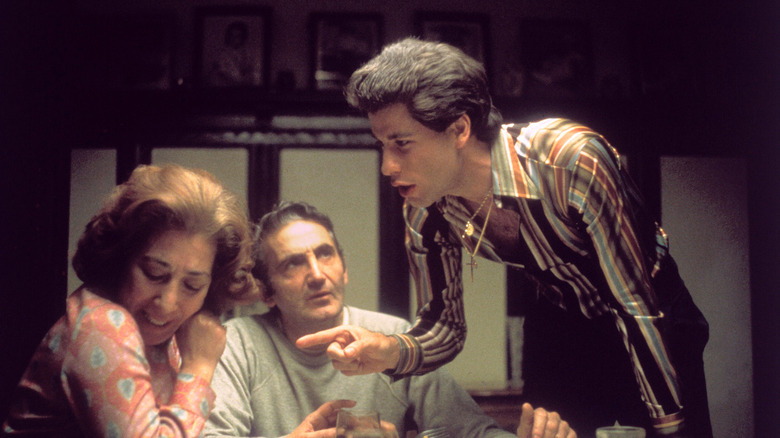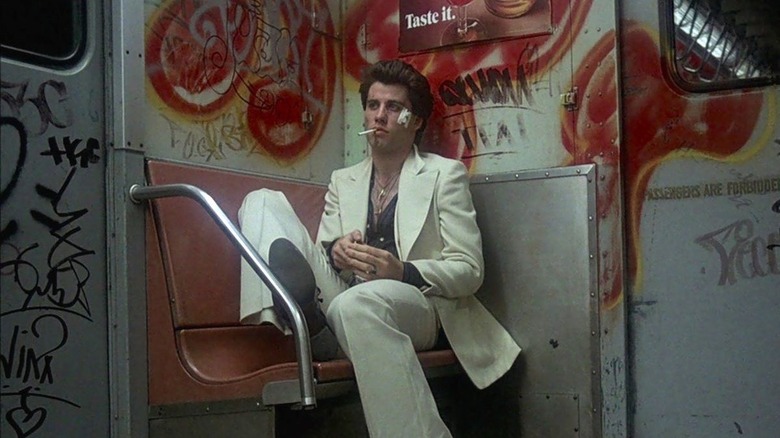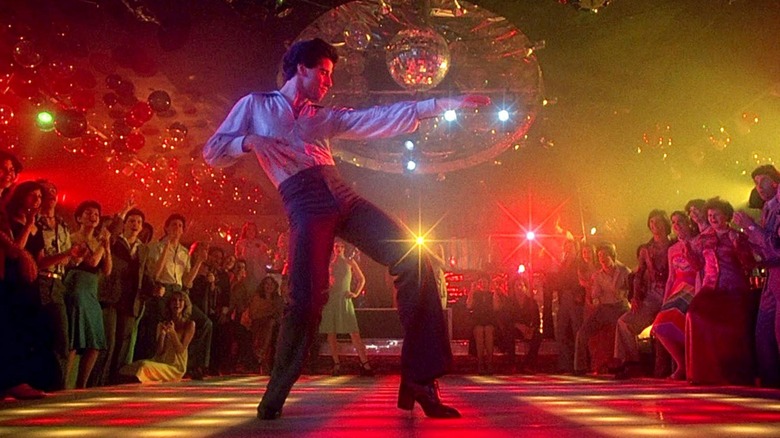John Travolta Trained Like Rocky Balboa To Prepare For Saturday Night Fever
A guy walking down the street is a common everyday sight. I even did it myself earlier today, traveling from my apartment to the cafe to write this article, but few of us regular blokes can make it as cool as our counterparts in the movies. Whether we're talking about the doomed death march of "The Wild Bunch," the gang strolling off their breakfast in slow-mo in "Reservoir Dogs," or Richard Roundtree prowling the streets in "Shaft," this simple act of locomotion, developed millions of years ago by our early ancestors, can become iconic when captured on film.
John Badham's disco relic "Saturday Night Fever" opens with one of the most famous struts in cinema history as Tony Manero (John Travolta), looking sharp as he swings a can of paint, checks out women, and orders a double slice of pizza swaggers through a gritty Brooklyn neighborhood to "Stayin' Alive" by the Bee Gees. I mean, why wouldn't he? Is it even possible to walk any other way to that track?
Released in December 1977, the box office smash was the moment disco really went mainstream and ultimately sowed the seeds of its destruction, as well as unleashing peak Bee Gees; the multi-platinum selling soundtrack dominated the charts and made the Brothers Gibb the ubiquitous voice of disco on both sides of the Atlantic. "Saturday Night Fever" was also the beginning of peak Travolta, who deservedly received an Oscar nomination for his hungry performance. The movie's shape-throwing success made him a superstar, followed by his winning turn as Danny Zuko in "Grease" the following year. It may even be the best role of the actor's uneven career but, if he made the dance moves look effortless, he was certainly put through his paces to get in shape for the part.
So what happens in Saturday Night Fever again?
Tony Manero (John Travolta) is a 19-year-old Italian-American kid from Brooklyn whose prospects are grim; he works a menial job at a local paint store and lives at home with his family. His relationship with his unemployed father (Val Bisoglio) and devoutly Catholic mother (Julie Bovasso) is a constant war at the dinner table as they both idolize his older brother Frank Jr. (Martin Shakar) who has become a priest.
Without much going for him, Tony lives for the weekend when he hits the local disco with his rowdy group of buddies for nights of drinking, drugs, and hookups. Tony is more interested in the music because he is treated like a local celebrity for his moves on the dance floor, and it's the only place he gets any respect and admiration.
One of his regular dance partners is Annette (Donna Pescow), a hanger-on he once dated but now treats like dog dirt. He reluctantly agrees to practice with her for an upcoming dance contest with a $500 prize but he already has his eye on snooty newcomer Stephanie (Karen Lynn Gorney), who works in Manhattan and looks down on him. Still, they find that they can dance really well together and a bond between them grows.
As the contest approaches, one of Tony's best friends is savagely beaten by a Puerto Rican gang called the Barracudas (at least, that's what he tells them) and his other pals want revenge. Can Tony juggle his dead-end job, a little gang-related violence, and get his steps down right in time for the big night? And is there any future for him beyond the dance floor and the neighborhood?
John Travolta had to train like Rocky for the role
Producer Robert Stigwood had signed up rising talent John Travolta to a three-picture deal and needed something to put him in while they waited for the stage run of "Grease" to end (via Vanity Fair). In the meantime, he found a (mostly fictional) magazine article by British journalist Nik Cohen called "Tribal Rites of the New Saturday Night," supposedly based on the writer's observations of young guys in Brooklyn discos with little else going for them but their prowess on the dance floor.
Stigwood snapped up the rights and started looking for a director, He found John G. Avildsen, who had just made a little picture called "Rocky." In hindsight, Avildsen sounds like the perfect fit for another underdog story about a big dreamer from the wrong side of the tracks, trading out Rocky's baggy leather jacket and fedora for Tony Manero's Cuban heels and mile-long collars. Unfortunately, the director rubbed just about everybody the wrong way including his young star, taking issue with Travolta's weight and dancing ability.
He brought in Jimmy Gambina, an ex-boxer who worked with Sylvester Stallone on his previous movie, to whip the actor into shape. Kevin McCormick, Stigwood's former assistant, recalled (via Vanity Fair):
"[It] was really good... because Travolta is prone to be soft and not that energetic, but Gambina ran him like he was a fighter."
Avildsen was fired on the same morning he received his Oscar nomination for "Rocky," but his frustrating time on "Saturday Night Fever" at least worked wonders for Travolta's physique. He's incredibly lean in the movie without an inch of fat on him, and it no doubt helped him pull off the more energetic dance moves.
Does Saturday Night Fever still hold up?
"Saturday Night Fever" might just be the most misremembered and misapprehended movie of the '70s. I've read several shocked articles from people who have gone in expecting a fun disco musical with lots of Bee Gees and dancing, but what they got was one of the grittiest slices of social realism to come out of America at the time. It's got the moves but it also has more in common with British New Wave classics like "Saturday Night and Sunday Morning" than disco duds such as "Xanadu" or "Can't Stop the Music."
The dance scenes are only a small part of it; the rest of the movie is a raw and salty look at deadbeat lives with little hope of a better future. There is gang violence, sexual assault, and suicide, not to mention frequent ethnic and homophobic slurs. Director John Badham observes it all with a sober lack of inflection, letting the characters do the talking and giving the film a fly-on-the-wall feel.
At the center, John Travolta's star-making performance is really brave. He doesn't shy away from Tony Manero's many unsavory aspects at all; like almost everyone else in the movie he is totally dislikable, but Travolta's charisma makes him riveting. Like his character, he really comes alive during the dance scenes, which are a treasure trove of retro fashions and wall-to-wall disco classics. Here is where we see Manero for what he could be and Travolta is totally in the moment, especially when he busts out the solo moves to "You Should Be Dancing." "Saturday Night Fever" was dated almost the moment it was released, but few movies capture the exhilarating feeling of losing yourself in the music better.



